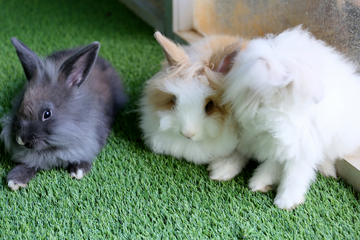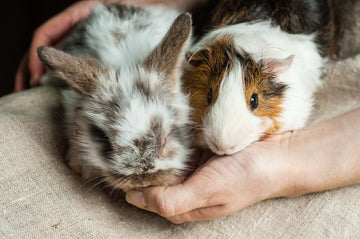What To Do If You Find Wild, Newborn Bunnies?
Wild rabbits have a long breeding season compared to many other animals. Breeding season for wild rabbits starts around Valentine’s Day and extends well into the summer. Their month-long gestation cycle means that a single wild rabbit can bear several litters of kits (baby rabbits) each year.
Click Here For a Guide to Feeding Your Baby Rabbits.

When you factor in the increasing human encroachment on rabbits’ and other wild creatures’ habitats, it is no wonder that wild rabbits and people often encounter each other outdoors. Typically, these are fleeting contacts – a glimpse of a cottontail before it disappears into a thick brush or trees.
On occasion, however, humans doing yardwork or enjoying a stroll through the woods come across what they believe are abandoned baby rabbits. What happens next is crucial for the survival of the litter of kits.
Are Those Babies Really Abandoned?
There’s a good chance that they are not. People wonder, "Will the mom come back to the nest?” If they are left undisturbed, it’s likely that she will. Kits eat only twice a day – at dawn and dusk. If the kits are together in a nest, they should be fine.
But What if Mom Doesn't Come Back?
The woods and skies (and even suburban backyards) are full of predators with rabbits high on their lists of food sources. If a mama rabbit has fallen victim to an owl, snake or other carnivore, the baby kits don’t stand much chance of making it on their own.
But keep in mind that wild rabbits are ready to leave the nest at just three weeks old. At that point, they are about the size of an adult chipmunk. They can hop on their own, their ears are erect, they have all their fur, and their eyes are fully open. They need no human intervention to make it on their own.
How to Tell if Mama Rabbit is Still Around
The Humane Society of the United States recommends a simple way to determine whether the kits are indeed abandoned. String pieces of yarn or place an array of twigs in a grid-like pattern over the kits’ nest. Leave it undisturbed until the next dusk or dawn and return to see if the pattern has been disturbed. If it has, the mother has been back to feed her babies, and all is well in their world.
If the nest looks just like you left it or you hear the rabbits making small cries of hunger, you will need to act. Otherwise, the kits will die of starvation or exposure to the elements. The best way to help them survive is to contact a professional wildlife rehabilitator in your area. The next best option is to call your vet for advice and guidance.
Sometimes those options aren’t practical at the moment. Then, it is up to you to intervene without causing further harm. You must learn what to feed them as newborns for them to survive and thrive. The goal should be to rehabilitate the babies so that they can be released back to the wild when they reach three weeks.
You will need some kitten milk replacer (KMR) -- yes, the same kind of formula you would feed to an abandoned litter of kittens. It most closely resembles the milk their mother naturally provides them.
Below are the age-appropriate amounts of KMR to feed the kit(s):
Newborn kits – 5 cc’s in an eye dropper.
Kits approximately two weeks old – 7 to 13 cc’s dependent upon size and appetite. Do not overfeed.
Three-week-old kits – 15 cc’s (and you can begin weaning them off the KMR to solid foods at this point).
Feed the kits only at dawn and dusk, just as their mother would. To prevent wild rabbits from choking during the feeding process, cradle them in your hands with their bellies up just as human babies are fed. Position the eye dropper on their mouths so they can suck the formula from the dropper. If they feed too quickly, they risk choking.
What to Do if Your Dog Disrupts a Nest of Kits
If your dog mauls a nest of kits, remove any survivors and create a new nest out of a cardboard box and soft cotton cloths, rags, or even old T-shirts so they stay warm and cozy. Feed them as described above and get them to a vet or professional wildlife rehabilitator as soon as possible.
Can You Keep Them as Pets?
Wild rabbits need to be returned to their native habitats. Don’t socialize them or they won’t learn to fear humans. If you looking to add a pet rabbit to your family, contact your local animal shelter or your nearest House Rabbit Society to see about adopting one.
Has your domestic pet rabbit had babies and you're not sure if they're feeding your new baby rabbits? Do you need to know how to feed your baby rabbits by yourself? Download our Human's Guide to Feeding Baby Rabbits to learn about what to look for in your baby rabbits, feeding techniques, a feeding schedule and more! We pride ourselves on supporting a community of small pet owners who care deeply about providing happy and healthy lifestyles for their pets.

Fun and Unique Names for Rabbits

Healthy Rabbit Treats for Hoppy Pets






![RHDV2 Critical Information + Frequently Asked Questions [Updated 03/20/2025]](http://www.rabbitholehay.com/cdn/shop/articles/rhdv2-critical-information-frequently-asked-questions-V1.png?v=1742490107&width=360)

